Tonga volcano: ‘Atomic bomb’ shook island as toxic ash threatens drinking water supply
Aid workers described how “the whole island shook” as they scramble to salvage Tonga’s drinking water from toxic ash contamination.
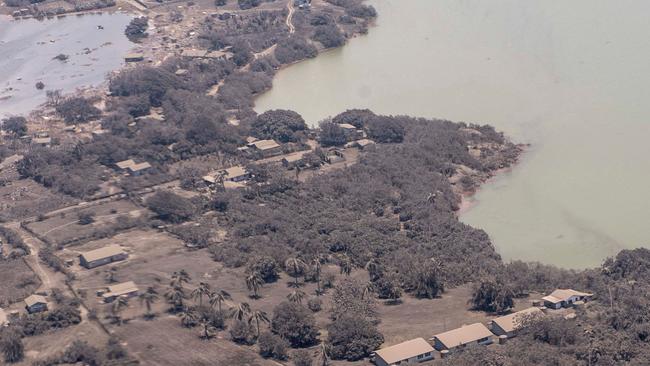
World
Don't miss out on the headlines from World. Followed categories will be added to My News.
Dramatic eyewitness accounts of a nuclear-force explosion have emerged as toxic ash and saltwater contamination threatens Tonga’s rapidly deteriorating freshwater supply.
The explosion of Hunga Tonga-Hunga Ha’apai felt like an “atomic bomb” that shook “the whole island”, an aid worker said almost a week after the duel eruption and tsunami cut off the Pacific nation from the world.
On Tongatapu, Tonga’s main island, “we felt a big... it was like an atomic bomb,” said Sione Taumoefolau, the secretary-general for the Tonga Red Cross.
“The whole island shake because of the noise of the eruption.” The situation remains difficult, with only limited supplies of aid getting in and residents facing a massive clean up effort.
“The worst part, for us, is the ash. Everywhere we are being covered by the ashes from the volcano,” Taumoefolau said.
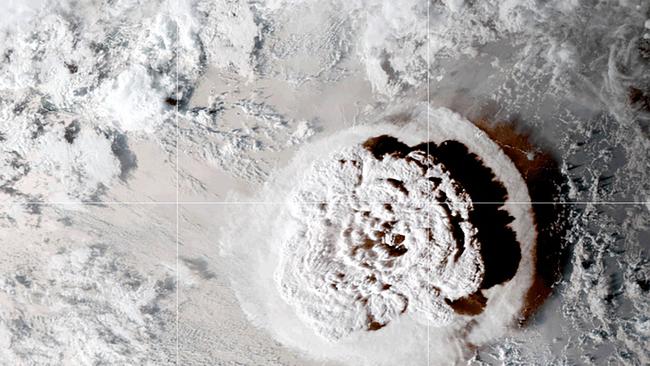
UN crisis co-ordinator Jonathan Veitch said from Fiji the key concern now for Tongans is drinking water, with water supplies for tens of thousands feared contaminated by ash or saltwater.
“Prior to the eruption, the majority of Tongans relied on rainwater,” Veitch said. “If it’s all basically made toxic by the by the ash, then they have a problem, unless they have access to groundwater sources.” Determining the location of and access to groundwater sources is now vital, he said.
Water testing has begun, but after last Saturday’s eruption “the entire country is covered in ash”, Veitch said.
The relief effort got underway in earnest on Thursday after Tonga’s main runway was cleared of ash, allowing the arrival of military aid flights from Australia and New Zealand.
But the sheer distance, crippled communications, and the bid to keep Covid out of the kingdom of 170 islands are hampering the recovery.
Tonga has been virtually cut off from the outside world since the volcanic blast broke an undersea communications cable, which may remain severed for weeks.
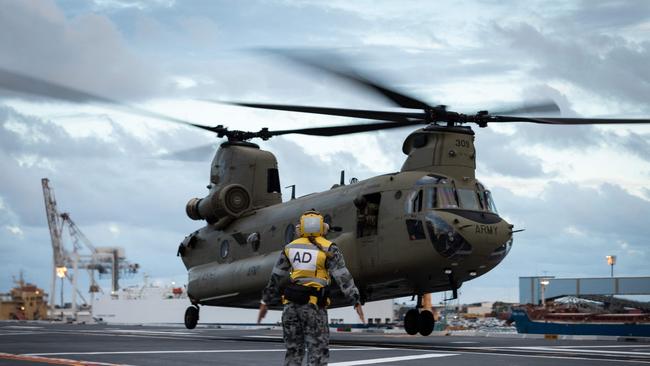
FIRST AID FLIGHTS ARRIVE
The first humanitarian flights arrived in volcano and tsunami-stricken Tonga five days after
one of the largest volcanic explosions in decades cloaked the nation in a layer of ash, triggered a Pacific-wide tsunami and severed vital undersea communication cables.
While partial communications were restored on Wednesday, mobile phone network provider Digicel said the high number of calls to the island was producing delays.

It is expected to be at least a month before the undersea cable connection is fully restored.
Two large military transport planes from Australia and New Zealand touched down at Tonga’s main airport on Thursday — only recently cleared of a thick layer of ash after painstaking effort.
“Landed!” said Australia’s international development and Pacific Minister Zed Seselja, hailing the arrival of a C-17 “carrying much needed humanitarian supplies”.
“A second C-17 is now on its way,” he added.
Among the equipment on board was said to be a “skid-steer loader with a sweeper” to help keep the runway clear of ash.
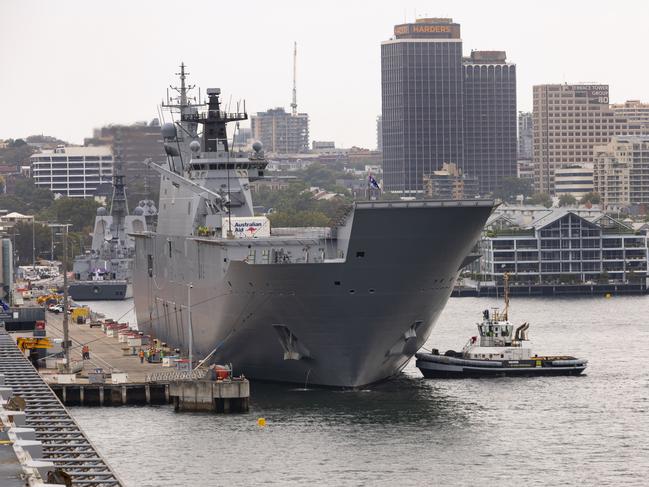
Defence Minister Peter Dutton said more Aussie flights will follow.
“Just after midnight, we had a flight on HMAS Adelaide depart Brisbane, and is on its way, it has all the stores and equipment, all the aid we are able to provide, we had a C70 land yesterday, and there are plans for more planes to depart Australia including today,” Mr Dutton told the Seven Network.
“We are working closely with the Tongan government to understand their needs. They need support on the ground to help them rebuild as quickly as possible, in particular their communication system which has been done. That is a real problem.”

New Zealand confirmed its C-130 Hercules has also landed.
“The aircraft is carrying humanitarian aid and disaster relief supplies, including water containers, kits for temporary shelters, generators, hygiene and family kits, and communications equipment,” New Zealand foreign Minister Nanaia Mahuta said.
Royal New Zealand Navy ships HMNZS Wellington and HMNZS Aotearoa are also on their way to Tonga.
They are carrying water supplies and a 70,000-litre a day desalination plant, as well as navy hydrographic and dive personnel to survey shipping channels.
More than 80 per cent of the archipelago’s population of 100,000 have been impacted by the disaster, the United Nations has estimated, and initial assessments indicate an urgent need for drinking water.
Landed! 🛬
— Zed Seselja (@ZedSeselja) January 20, 2022
🇦🇺's first RAAF flight carrying much needed humanitarian supplies has landed in Tonga, & a second C-17 is now on it's way.
These flights will deliver shelter, hygiene kits, PPE for people clearing ash, water containers, & other supplies to support immediate needs 🇦🇺🇹🇴 pic.twitter.com/CFyBwrkxck
The first smattering of images to emerge from Tonga’s capital Nuku’alofa show ashen buildings, toppled walls and streets littered with boulders, tree trunks and other debris.
Tongans worked for days at the airport trying to clear the runway of ash so that much-needed aid could arrive.
The work was painfully slow, with only a few hundred metres being cleared each day.
With the air bridge now open, nations are rushing to get aid in. Japan has announced it will send two C-130 aircraft, and nations from China to France have indicated they will also provide assistance.
But strict Covid protocols that have kept Tonga virtually virus-free mean the delivery of supplies will be “contactless”.
New Zealand commander James Gilmour said: “There will be no contact between the New Zealand Defence Force and anyone on the ground.”
The crew was only expected to be on the ground for 90 minutes.
‘UNPRECEDENTED DISASTER’
Three people were killed when the Hunga Tonga-Hunga Ha’apai volcano exploded on Saturday, triggering tsunami waves that ripped down homes and caused widespread flooding.
The overwhelmed Tongan government has called the dual eruption-tsunami “an unprecedented disaster” and reported that waves as high as 15 metres destroyed almost every home on some outlying islands.
Virtually the entire population of 100,000 people has been affected, and initial assessments indicate an urgent need for drinking water.
When the underwater caldera exploded, it fired debris 30 kilometres into the air and deposited ash and acid rain across the kingdom of 170 islands – poisoning water supplies.
“Water supplies across Tonga have been severely impacted by ashfall and saltwater from the tsunami,” said Katie Greenwood of the International Federation of Red Cross and Red Crescent Societies.
She said there was a “mounting risk of diseases such as cholera and diarrhoea”.

China said it would send emergency supplies such as drinking water, food and disaster relief equipment when flights allowed.
France, which has territories in the South Pacific, pledged to help the people of Tonga’s “most urgent needs”.
There are fears for the island’s food supplies, with a tearful speaker of the National Assembly Fatafehi Fakafanua saying “all agriculture is ruined”.
“It’s very sad to hear, so on top of the water that we need in Tonga, it seems that we’ll be facing a food shortage,” he told the Pacific Media Network.
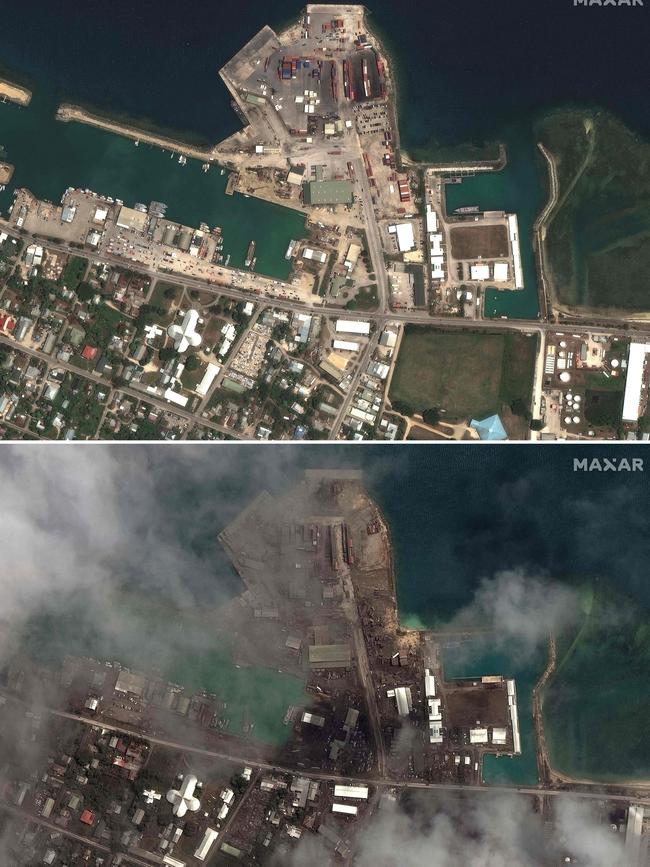
INTERNATIONAL CALL SERVICES BACK UP
The eruption was one of the most potent in decades, releasing a pressure wave that traversed the planet, travelling at supersonic speeds of about 1230 kilometres per hour, New Zealand’s National Institute of Water and Atmospheric Research said.
It broke a vital undersea communications cable that links Tonga with the rest of the world. Partial communications were restored on Wednesday with mobile phone network provider Digicel announcing “international calls service is back up”.
There had been little news from the islands since Saturday, except for a handful of messages delivered through satellite phones, with a complete restoration of services weeks away.
“US cable company SubCom advises it will take at least four weeks for Tonga’s cable connection to be repaired,” New Zealand’s foreign ministry said Wednesday.
The company said the cable appears to be severed in two places – one is 37 kilometres offshore and the other is a domestic cable close to the volcano, making repairs difficult.
A repair ship is en route from neighbouring Papua New Guinea. The Red Cross reached its team in Tonga via satellite phone on Wednesday for the first time since the tsunami.
The organisation sent an emergency team to the hard-hit islands of Mango, Fonoifua and Namuka.
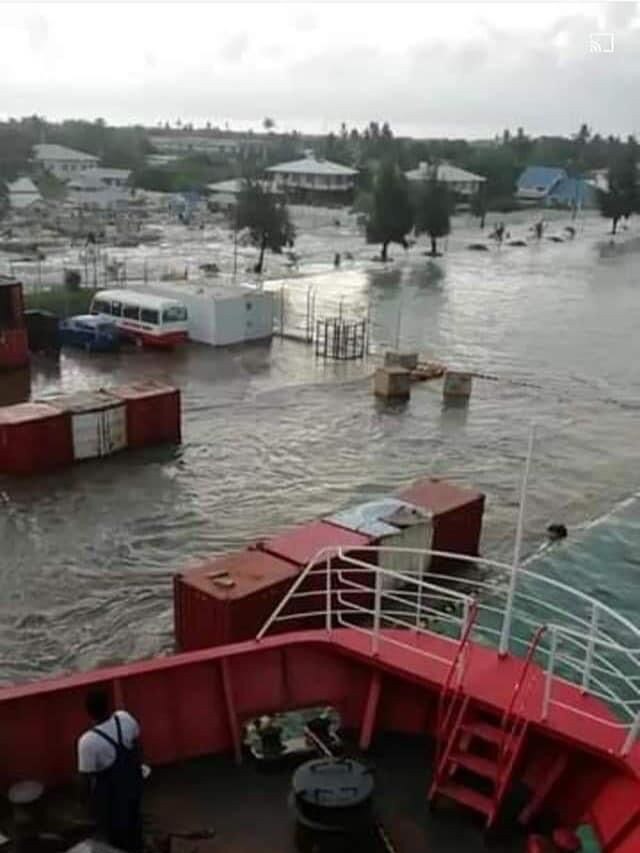

A village on Mango island, where a distress beacon was detected earlier in the week, was destroyed, and only a few houses remained standing in several other villages across the archipelago, Tonga’s government said.
Neighbouring countries have relied on surveillance flights and satellite images to assess the scale of the disaster.
Images released by the UN showed vast areas covered in ash and evidence of inundated roads, toppled walls and smashed buildings across the archipelago.
On Tuesday, satellite images released by Maxar Technologies showed there is now open water where most of the volcanic structure stood above sea level a few days ago.
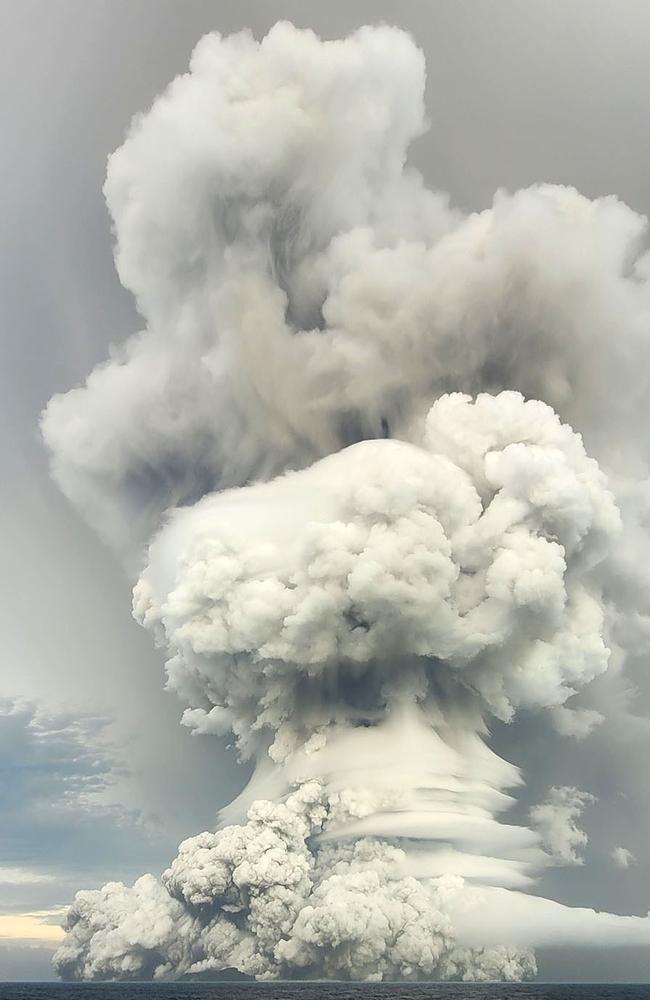
Only two relatively small volcanic islands were still visible above sea level after the eruption.
A 65-year-old woman in Mango was one of three people confirmed dead, along with a 49-year-old man and a British national.
Multiple injuries were also reported, the government said.
Tongan navy vessels carrying health workers and laden with supplies of water, food and tents were being deployed.
“The evacuation process has begun,” the government’s statement said.

FIGHT TO KEEP AID EFFORT COVID-FREE
The United Nations said on Tuesday it would try to maintain Tonga’s Covid-free status in the relief effort following the volcano eruption and subsequent tsunami that hit the Pacific island nation.
Humanitarian efforts to help the remote Pacific kingdom will follow the country’s strict protocols for keeping out the coronavirus pandemic, UN agencies told reporters in Geneva, according to AFP.
“Tonga is a zero-Covid country,” said Jens Laerke, spokesman for the UN Office for the Coordination of Humanitarian Affairs.
“They have very strict protocols for that. One of the first rules of humanitarian action is ‘do no harm’,” he said.

“So we want to make absolutely sure that all necessary protocols for entry into the country will be followed.”
Tonga only recently reported its first and only coronavirus case. Sixty per cent of the country’s population of over 100,000 people are fully vaccinated against Covid-19, according to figures from the World Health Organisation.
The WHO said on Tuesday it was for the Tongan authorities to balance their priorities between maintaining their Covid regulations and getting in urgently-needed support.
“It’s up to the government to give out the guidance and the rules on how to enter the country, what protocols have to be in place,” WHO spokesman Christian Lindmeier said.
“But yes, it certainly will be a priority to see that contamination can be avoided as much as possible.”
BRIT AMONG THE DEAD
One of the three people confirmed dead was Briton Angela Glover, a 50-year-old who ran a stray animals charity and was reported missing by her husband after the tsunami hit.
“Earlier today my family was sadly informed that the body of my sister Angela has been found,” her brother Nick Eleini said after being given the news by the husband, James Glover.
“James was able to cling on to a tree for quite a long time, but Angela was unable to do so and was washed away with the dogs,” he told The Guardian newspaper.
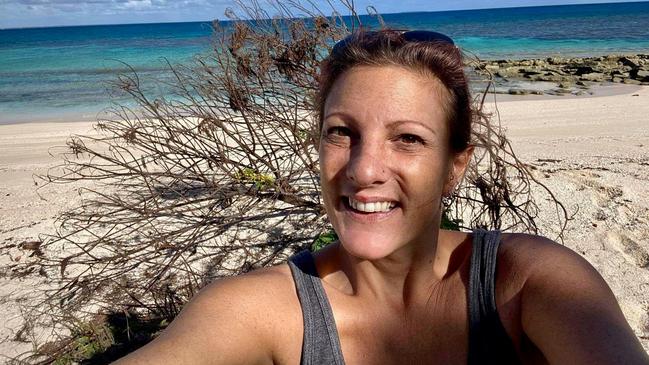
The day before she was killed, Ms Glover sent an Instagram post of the sunset after Hunga Tonga-Hunga Ha’apai volcano erupted, describing the sea swell and electrical storms.
“We’ve been under tsunami warnings today,” she wrote and added “everything looked like I was watching through an Instagram filter”.
Glover ran an animal shelter in Tonga, and was well loved by the community there, her brother told The Guardian. He said her body had been found by her husband, James, after a search.
A former marketing and advertising worker, Glover had been living in Tonga with her husband since 2015.
A 65-year-old woman from Mango and 49-year-old man from Nomuka island were also killed.
Originally published as Tonga volcano: ‘Atomic bomb’ shook island as toxic ash threatens drinking water supply




